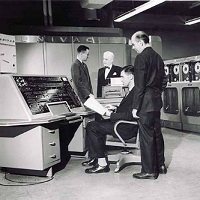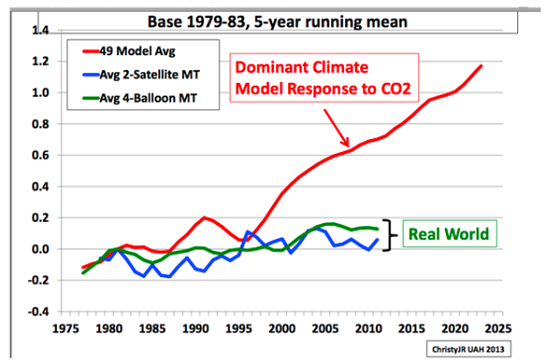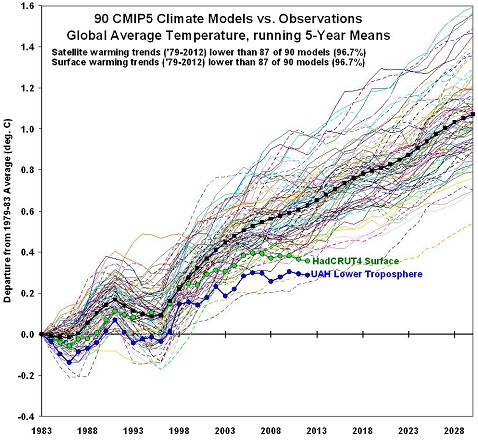
The Computer Models
It is obvious to any disinterested observer (i.e., anyone not funded by a government) that the alarmists are in disarray. Their models–the sole basis for their predictions of catastrophic warming–have been shown to have no ability to forecast the future. And, in fact, they don’t even hindcast very well. -John Hinderaker
Climate change prophecy hangs its hat on computer climate models. The models have gigantic problems. According to Kevin Trenberth, once in charge of modeling at the National Center for Atmospheric Research, “[None of the] models correspond even remotely to the current observed climate [of the Earth].”
The models can’t properly model the Earth’s climate, but we are supposed to believe that, if carbon dioxide has a certain effect on the imaginary Earths of the many models it will have the same effect on the real earth.
The climate models are an exemplary representation of confirmation bias, the psychological tendency to suspend one’s critical facilities in favor of welcoming what one expects or desires.
-Norman Rogers, "The Profound Junk Science of Climate" 
What has happened in the past 10 years is that the discrepancies between what’s observed and what’s predicted have become much stronger. It’s clear now the models are wrong, but it wasn’t so clear 10 years ago.
-Freeman Dyson 
“There is this mismatch between what the climate models are producing and what the observations are showing,” says lead author John Fyfe, a climate modeller at the Canadian Centre for Climate Modelling and Analysis in Victoria, British Columbia. “We can’t ignore it.” -Jeff Tollefson

“Temperature measurements show that the [climate model-predicted mid-troposphere] hot zone is non-existent. This is more than sufficient to invalidate global climate models and projections made with them!”
-UN IPCC Scientist Dr. Steven M. Japar, a PhD atmospheric chemist who was part of Intergovernmental Panel on Climate Change’s (IPCC) Second (1995) and Third (2001) Assessment Reports 
Since 1990, scientists have used complex models to predict how climate change and manmade greenhouse emissions will affect the world. But a team of experts - including an astrophysicist, statistician, and geography professor – has claimed these models ‘very greatly exaggerate’ the effects of global warming. 
The models differ in their descriptions of the past century's global average surface temperature by more than three times the entire warming recorded during that time. -Steven E. Koonin 
Kevin Trenberth, a lead author of 2001 and 2007 IPCC report chapters, writing in a 2007 “Predictions of Climate” blog appearing in the science journal Nature.com, admitted: “None of the models used by the IPCC are initialized to the observed state and none of the climate states in the models correspond even remotely to the current observed state”. 
Further, their predictions rest on models they fall in love with: “You sit in front of a computer screen for 10 years and you start to think of your model as being real.”
Not surprisingly, these models have been “consistently and spectacularly wrong” in their predictions, write atmospheric scientists Richard McNider and John Christy — and always, amazingly, in the same direction. -Charles Krauthammer 
Warming, Liberal, Science, Narrative, Oops
Earth's atmosphere, it turns out, is dustier than scientists previously thought.
Dust in the upper atmosphere interacts with clouds, oceans and even radiation, or heat, from the sun. It can affect weather, precipitation and even has an impact on climate change. In a new study, scientists from the University of California Los Angeles (UCLA) found that there is four times as much coarse dust in our planet's atmosphere than has previously be seen in climate models.
Another group of prominent climate scientists have published research claiming humanity may have a couple extra decades before pushing the world past what the U.N. calls “dangerous” levels of global warming...
The study, published in the journal Nature Geoscience, provides more confirmation the climate models are running too hot and could not predict the 15-year “hiatus” in global warming.
“We haven’t seen that rapid acceleration in warming after 2000 that we see in the models. We haven’t seen that in the observations,” Myles Allen, a geosystem scientist at the University of Oxford, told The Times on Monday.
Environmentalist, Warming, Science, Narrative, Oops
Predictions of unprecedented rainfall extremes in the 20th century driven by global warming turned out wrong, a study said Wednesday, casting doubt on methods used to project future trends.
A massive trawl of Northern Hemisphere rainfall data for the last 1,200 years revealed there had been more dramatic wet-dry weather extremes in earlier, cooler centuries before humans set off fossil fuel-driven global warming.
This is problematic, said a study in the journal Nature, as the same data models used to anticipate that global warming would cause record rainfall extremes in the 1900s, are the basis for projections of things to come.
Environmentalist, Warming, Science, Oops
A new Yale-led study estimates that there are more than 3 trillion trees on Earth, about seven and a half times more than some previous estimates... The new insights can improve the modeling of many large-scale systems, from carbon cycling and climate change models to the distribution of animal and plant species, say the researchers.
That’s what makes it so striking to find that this debate is very much not over — a group of top scientists has just published a paper in Nature Climate Change robustly defending the idea that, as they put it, “The observed rate of global surface warming since the turn of this century has been considerably less than the average simulated rate” produced by climate change models. -Chris Mooney 
Environmentalist, Warming, Science, Un, Oops
The paper – Rethinking the lower bound on aerosol radiative forcing by Bjorn Stevens of the Max Planck Institute for Meteorology in Hamburg, Germany, published in the American Meteorological Society journal – finds that the effects of aerosols on climate are much smaller than those in almost all the computer models used by the Intergovernmental Panel on Climate Change.
The new Stevens paper has been described as a “game-changer” by one expert in the field, Nic Lewis. According to the IPCC’s models, the effect of aerosols on climate could be as much as 4.5 degrees C. But Stevens paper suggests that this is a considerable overestimate and that the reduction they effect on temperature cannot be more than 1.8 degrees C.
A Total Mismatch
Between Models and Observations

While the average of 49 AGW-model runs of the CMIP5 models used by the IPCC rises diagonally upwards from 1977 by around +1.0 °C in 2015 (i.e. today), the observational records remains fairly stable at about +0.2 °C today (Fig 2).
This means a total mismatch between models and observations. In this position, is there on the whole any doubt what science must choose? – the observational facts, of course. -Nils-Axel Mörner
Environmentalist, Warming, Liberal, Science, Narrative, Oops
Vast ranges of volcanoes hidden under the oceans are presumed by scientists to be the gentle giants of the planet, oozing lava at slow, steady rates along mid-ocean ridges. But a new study shows that they flare up on strikingly regular cycles... Scientists have already speculated that volcanic cycles on land emitting large amounts of carbon dioxide might influence climate; but up to now there was no evidence from submarine volcanoes. The findings suggest that models of earth’s natural climate dynamics, and by extension human-influenced climate change, may have to be adjusted.
The fact that environmentalists have reliably been wrong in predicting the climate over the past 50 years doesn't seem to bother any of these self-styled truth-seekers.
Environmentalist, Warming, Government, Fraud, Science, Un
But the real action (and the evidence for chicanery) is in the computer code obtained from the CRU. Our own computer guru Marc Sheppard, writing for American Thinker here and here, was one of the first to offer an accurate diagnosis of this fraudulent method of computer programming.
Proponents further claim (and the computer models purport to show) that temperatures will continue to increase exponentially. The implication is that unless we drastically curtail human output of CO2, the "escalation" in temperature is going to get even worse even faster. Turns out that these claims are absolutely false, and the computer models have been rigged.
If climate scientists can’t get the models to actually work, then why should we take their predictions seriously? Remember, they want to create irreparable harm to the economy in an effort to combat this problem that they clearly don’t understand well enough to model effectively.
So yeah, I’m not as concerned as I once was.
Environmentalist, Warming, Liberal, Science, Narrative, Oops
Scientists are struggling to explain a slowdown in climate change that has exposed gaps in their understanding and defies a rise in global greenhouse gas emissions. Often focused on century-long trends, most climate models failed to predict that the temperature rise would slow, starting around 2000... Some experts say their trust in climate science has declined because of the many uncertainties.
The UN's Intergovernmental Panel on Climate Change (IPCC) had to correct a 2007 report that exaggerated the pace of melt of the Himalayan glaciers and wrongly said they could all vanish by 2035. "My own confidence in the data has gone down in the past five years," said Richard Tol, an expert in climate change and professor of economics at the University of Sussex in England.
The Science Is Insufficient ...
Humans exert a growing, but physically small, warming influence on the climate. The results from many different climate models disagree with, or even contradict, each other and many kinds of observations.
In short, the science is insufficient to make useful predictions about how the climate will change over the coming decades, much less what effect our actions will have on it.
Why are recorded temperatures, particularly from satellites and weather balloons, so much lower than the alarmist models had predicted? How do you explain an almost-20-year "pause" in increasing temperatures even as CO2 emissions have accelerated?
Environmentalist, Warming, Liberal, Government, Incompetence, Science, Narrative, Oops, Politics
Christy said he has examined the climate models used for the latest IPCC report, all of which failed to account for the lack of warming since 1996. He told CNSNews that he analyzed all 73 models used in the latest IPCC report (Fifth Assessment Report or 5AR) and not one accurately predicted that the Earth’s temperature would remain flat since Oct. 1, 1996.
Warming, Science, Oops
Several climate models indicate that in a 2 × CO2 environment, temperature and precipitation would increase and runoff would increase faster than precipitation. These models, however, did not allow the vegetation to increase its leaf density as a response to the physiological effects of increased CO2 and consequent changes in climate.
Warming, Science, Oops, Fear
A group of top NASA boffins says that current climate models predicting global warming are far too gloomy, and have failed to properly account for an important cooling factor which will come into play as CO2 levels rise.
Climate Models Vs. Actuals
As seen in the following graphic, over the period of the satellite record (1979-2012), both the surface and satellite observations produce linear temperature trends which are below 87 of the 90 climate models used in the comparison. -Roy Spencer











